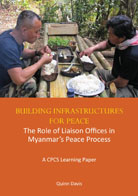Liaison Offices Learning Paper available in Burmese
 Building Infrastructures for Peace: The Role of Liaison Offices in Myanmar’s Peace Process, a Learning Paper published by CPCS, is now available in Burmese.
Building Infrastructures for Peace: The Role of Liaison Offices in Myanmar’s Peace Process, a Learning Paper published by CPCS, is now available in Burmese.
Based on CPCS observations and interviews with over 100 liaison office staff, this paper provides an analysis of liaison offices in the scope of the larger peace process to provoke insights on how liaison offices can work. It concludes with a series of recommendations for providing greater support to liaison offices so they can fulfill their potential as effective structural supports of peace in Myanmar.
The importance of establishing infrastructure to sustain and promote a country’s progress towards peace has attracted growing attention as a core component of sustainable peacebuilding.
 The term “peace infrastructure” or “infrastructure for peace” (I4P) is used to describe interconnected structures or mechanisms that span across all levels of society to foster more strategic, sustainable and locally rooted interventions to conflict.
The term “peace infrastructure” or “infrastructure for peace” (I4P) is used to describe interconnected structures or mechanisms that span across all levels of society to foster more strategic, sustainable and locally rooted interventions to conflict.
This paper examines the Myanmar peace process through a framework of peace infrastructure to identify spaces to strengthen the foundation of peace in Myanmar, namely by building the capacity of liaison offices, institutions that have been established to strengthen communication and coordination between conflict parties and facilitate wider community engagement in the peace process.
Use the links below to download in either English or Burmese or click here for an extract from the publication on What are Peace Infrastructures?

